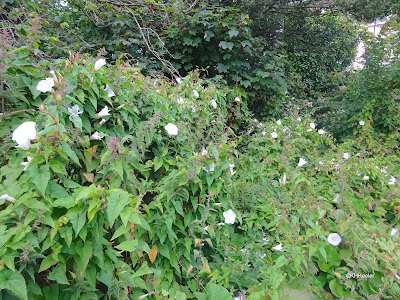In the regions where I have lived in the last 50 years, Colorado, Nebraska, I knew only two bindweeds, the very common field bindweed, Convolvulus arvensis (blog), and the much rarer, hedge bindweed, perhaps better called hege false bindweed Calystegia sepium, both with white tubular flowers open in the mornings. Hedge false bindweed is much bigger--and so quite beautiful--and although I saw it climbing through roadside shrubs, it didn't seem particularly weedy.
 |
| hedge false bindweed, Calystegia sepium |
 |
| hedge false bindweed, Calystegia sepium |
(Convolvulus didn't miss the calystegias, there are still 200-250 species of Convolvulus, most in Eurasia. However, this bit of naming makes purists twitch. Calystegia is derived from Convolvulus but recognized as a genus, equivalent to Convolvulus. That makes Convolvulus polyphyletic, not a single lineage of species but two, and best-practice taxonomy does not do that. Presumably one day Convolvulus will be broken into smaller more uniform and manageable pieces, each monophyletic.)
The name Convolvulus is from convolvulere, meaning "twisting " or "twining." Calystegia combines kalyx meaning "cup" and stege "covering", referring to the distinctive bracts that over the sepals in the genus. The species epithet sepium means "of hedges."
 |
| hedge false bindweed, Calystegia sepium, with small insect in flower |
The genus Calystegia as recognized today contains 30 species world wide, 20 in North America. Of those 20 native American species, 11 are found only in California, another 3 are western North American, one in the southeastern U.S., one on beaches and coasts worldwide, and one, Calystegia sepium, all over the U.S. and the world. The ten others include species found in Asia, Europe, southern Africa and Australia. DNA evidence indicates that Calystegia radiated from central Eurasia in the last 5 million years, finding its way to temperate regions all over the world very quickly and then diversifying into multiple species in the new lands. Most of the Calystegia species have variable leaf, stem and flower characteristics and form recognized geographical subspecies.
In this complicated group, hedge bindweed, Calystegia sepium, is particularly confusing. It is considered native to places all over the world, from Europe to Australia to North America. Botanists recognize eight subspecies, of which six are believed native to North America. It is found in every state and the southern Canadian provinces. That sounds like there are undetected species, but the DNA work is recent and finds too much similarity to call the various populations different species.
Hedge bindweed is a perennial that climbs and twines without tendrils. The flowers can be as large as 2 1/2 inches long. They open in early in the morning, and close about midday. Mostly the flowers are white but can have pink markings or be entirely pink. The white flowers should attract moths as well as butterflies and bees but I can find no study of flower visitors in North America. Flowers produce two to four hard seeds.
 |
| hedge false bindweed, Calystegia sepium |
My original belief that I knew hedge false bindweed when I saw it turns out to be wrong. Across most of the midwestern range of Calystegia sepium is also found Calystegia macounii. Macoun's false bindweed has only been identified in the last 30 years; older collections misidentified it as hedge false bindweed. The main difference between the two is that C. macounii is covered in short hairs, which are not present in C. sepium. In addition, Macoun's false bindweed trails along the ground rather than twines.
Europe has two species of false bindweed, Calystegia silvatica and C. pulchra, which are very similar to C. sepium and sometimes hybridize, so while they can sometimes be told apart, frequently people lump them, "Calystegia sepium agg." (aggregate).
In sum: hedge false bindweed, Calystegia sepium, is found, apparently native, all over the world, in eight distinct subspecies. In addition, it hybridizes with related species, creating plants that do not fit either species well. Finally, rapid speciation in the genus created a series of white-flowered false hedge bindweeds that are very, very similar. To identify a hedge false bindweed, be sure you have a recent identification book for your area, so you know which species have been reported nearby. Then look carefully for hairs, and at whether the bracts overlap, and if the leaves are rounded or pointed at the base (by the petiole).
 |
| hedge false bindweed in a Minnesota prairie |
Hedge false bindweed is rich in alkaloids call calysteigins. If ingested in quantity, hedge false bindweed will upset the stomach, but it is not toxic enough to be considered poisonous. In rural Ireland it was used as treatment for kidney problems.
Across the world, hedge false bindweed is lumped with field bindweeds (Convolvulus arvensis) as annoying, even aggravating, weeds. In parts of Ireland it was called "the tormentor" because it was so difficult to remove. It is nowhere near as common or aggressive as field bindweed, but it will climb all over your hedge.
 |
| hedge false bindweed draping other plants |
Comments and corrections welcome.
References
Ackerfield, J. 2023. Flora of Colorado. 2nd edition. Denver Botanic Gardens. Denver, Colorado.
Flora of North America. Calystegia. link Accessed 9/27/24.
Grieve, M. (originally 1932). A Modern Herbal. Dover Publications. New York.
Kaul, R.B., D. Sutherland, and S. Rolfmeier. 2011. The Flora of Nebraska. University of Nebraska Press, Lincoln.
Mac Coitor, N. 2023. Ireland's Wild Plantss. Myths, Legends and Folklore. The Collins Press. Cork, Ireland.
Mitchell, T. C., B. R. M. Williams, J. R. I. Wood, D. J. Harris, R. W. Scotland, and M A. Carine. 2016. How the temperate world was colonised by the bindweeds: biogeography of Convolvuleae (Convolvulaceae). BMC Evolutionary Biology. 16:16. (link) Accessed 9/28/24.
Stubbendieck, J., M.J. Coffin, and L.M. Landolt. 2003. Weeds of the Great Plants. Nebraska Department of Agriculture.
No comments:
Post a Comment